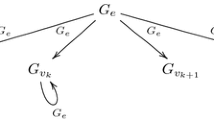Abstract
It is shown that a finitely generated pro-p group G which is a virtually free pro-p product splits either as a free pro-p product with amalgamation or as a pro-p HNN-extension over a finite p-group. More precisely, G is the pro-p fundamental group of a finite graph of finitely generated pro-p groups with finite edge groups. This generalizes previous results of W. Herfort and the second author (cf. [2]).
Similar content being viewed by others
References
W. Herfort and L. Ribes, Subgroups of free pro-p-products, Math. Proc. Cambridge Philos. Soc. 101 (1987), 197–206.
W. Herfort and P. A. Zalesskii, Virtually free pro-p groups, Publ. Math. Inst. Hautes Études Sci. 118 (2013), 193–211.
O. V. Mel’nikov, Subgroups and the homology of free products of profinite groups, Izv. Akad. Nauk SSSR Ser. Mat. 53 (1989), 97–120.
L. Ribes and P. A. Zalesskii, Pro-p trees and applications, in New horizons in pro-p groups, Progr. Math., Vol. 184, Birkhäuser Boston, Boston, MA, 2000, pp. 75–119.
L. Ribes and P. A. Zalesskii, Profinite groups, Ergebnisse der Mathematik und ihrer Grenzgebiete. 3. Folge. A Series of Modern Surveys in Mathematics [Results in Mathematics and Related Areas. 3rd Series. A Series of Modern Surveys in Mathematics], Vol. 40, Springer-Verlag, Berlin, 2000.
L. Ribes and P. A. Zalesskii, Normalizers in groups and their profinite completion, Rev. Mat. Iberoam. 30 (2014), 167–192.
J-P. Serre, Sur la dimension cohomologique des groupes profinis, Topology 3 (1965), 413–420.
J-P. Serre, Cohomologie des groupes discrets, in Prospects in mathematics (Proc. Sympos., Princeton Univ., Princeton, N.J., 1970), Princeton Univ. Press, Princeton, N.J., 1971, pp. 77–169. Ann. of Math. Studies, No. 70.
J-P. Serre, Trees, Springer-Verlag, Berlin, 1980, Translated from the French by John Stillwell.
J. R. Stallings, Groups of dimension 1 are locally free, Bull. Amer. Math. Soc. 74 (1968), 361–364.
J. R. Stallings, On torsion-free groups with infinitely many ends, Ann. of Math. (2) 88 (1968), 312–334.
J. R. Stallings, Group theory and three-dimensional manifolds, Yale University Press, New Haven, Conn.-London, 1971, A James K. Whittemore Lecture in Mathematics given at Yale University, 1969, Yale Mathematical Monographs, 4.
R. G. Swan, Groups of cohomological dimension one, J. Algebra 12 (1969), 585–610.
P. A. Zalesskii and O. V. Mel’nikov, Subgroups of profinite groups acting on trees, Mat. Sb. (N.S.) 135(177) (1988), 419–439, 559.
Author information
Authors and Affiliations
Corresponding author
Additional information
To W.N. Herfort on the occasion of his 70-th birthday
Partially supported by Capes and CNPq.
Rights and permissions
About this article
Cite this article
Weigel, T., Zalesskii, P.A. Virtually free pro-p products. Isr. J. Math. 221, 425–434 (2017). https://doi.org/10.1007/s11856-017-1548-1
Received:
Revised:
Published:
Issue Date:
DOI: https://doi.org/10.1007/s11856-017-1548-1



